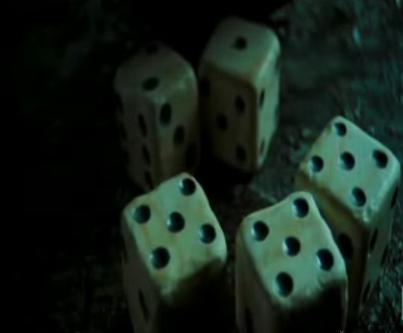Tic-Tac-Toe with added
chance
In order to add a few elements of chance to Tic-Tac-Toe I've changed a few things.
- Players now play on a 9x9 tic-tac-toe grid.
- The winner of the smaller 3x3 sections rolls a d6 and calls “High” or “Low” (or “Evens” or “Odds”)
- If their call is correct they claim that grid as their own.
- If not it becomes one type of “draw” grid.
- “Draws” can be challenged.
- Challengers roll 3 d6’s, defenders roll 2 d6’s, players compare the challenger’s 2 higher die faces with the defender’s die faces and the challenger’s 3rd die is ignored.
- If the challenger wins, they now own that grid.
- If the defender wins, the grid remains neutral and it becomes the next player’s turn.
 |
| The blank game. It can just be played on a regular piece of paper, just like Tic-Tac-Toe |
This adds multiple games that can be played out at the same
time, increasing the skill needed to win or defend the regular tic-tac-toe
grid. Since players can stop playing in a grid at any time, there is a better
chance they’ll be able to distract the player from moves made on one grid by
moving to win at a different grid.
This also gives the player that moves second (“O” player) a
new strategy to win. Normally, moving first gives that player (“X” player) a
slight advantage, but now the “O” player can choose to change to a different
grid at any time, thereby moving first within that grid. For example if the “X”
player uses the strategy of acquiring two lines that they can use to win, but
the “O” player can only block one, the “O” player can choose not to block
either but instead to change grids. This
gives the “X” player a choice to place an “X” to claim that grid or change
grids so as not to give the “O” player 2 moves in a grid.
 |
| "X" player can win if he challenges the center-left draw |
Modifying Battle
Hexagons
“Battle hexagons” was my group’s territorial acquisition game.
 |
| The board stays the same, the changes are to the game play |
- The player’s goal was to acquire the largest amount of hexagons in 20 rounds.
- Players collected wild cards if they landed on a “wild” space
- Players could jump between hexes if they landed on a “portal” space.
- Players could use a fair amount of skill to try and trap other players. Since tiles could not be re-claimed, players could easily be trapped and unable to move.
To remix it as a game based entirely on chance, any mechanic
based on skill must be removed or altered.
One of the main skill-based mechanics is the ability to trap
other players. This can easily be altered to have a combat system allowing
players to acquire another player’s territory, allowing them to not be cornered
into a small area. The new combat system would be simple:
- Both players roll the same number of dice, if the attacker’s dice are higher, they move into that player’s territory space.
- The player can then roll the die again for their movement, but they can only move half of their dice roll for that turn and only through free spaces.
- If the player needs to acquire more enemy territory they must wait until their next turn.
- If the defender wins the attacker does not move and play continues.
- In the event of a draw, the defender wins.
Another factor is the rounds. I would like to change it to “Play
until the board is filled” but I think that will add too much to the game play. If
there is no limit but the amount of spaces on the board then a player could
keep one open space protected until they have every other space. If two players
do this it would extend the length of game play indefinitely, but not in a good
way.
I think it is best to keep the goal as “the winner is the
player that acquires the most territory in 20 rounds”. That still keeps an incentive
to block your opponent’s path just to slow them down.
The only other factor in Battle Hexagons is the cards. Since
these are already randomized they do not need to be changed.
Overall, I believe that allowing players to take one another’s
territory will lead to more exciting game play.









